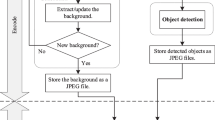Abstract
This paper presents a new technique to extract objects from a real complex background so that a video sequence can be decomposed into a set of objects as required for object oriented video compression techniques. The proposed method is based on a background subtraction technique. However, instead of using a fixed background, the system relies on predicting one from a previously constructed virtual model of the environment. Thus, camera movements are allowed. These movements are estimated by means of a tracker device. We also present the virtual model construction technique for indoor environments. The method has been successfully tested for several different video sequences including capture errors, partially mapped virtual environments and camera positioning errors. Further work will focus on extending the virtual models not only to environment, but also to objects, and integrating the method in a MPEG4 standard compression system.
Similar content being viewed by others
References
Collins, R., Lipton, A. and Kanade, T., A system for video surveillance and monitoring. Technical Report CMU-RI-TR-00-12, Robotics Institute, Carnegie Mellon University (2000)
Elgammal, A.M., Harwood, D. and Davis, L.S., Non-parametric model for background subtraction, Proc. of the 6th European Conference on Computer Vision, 2 (Ireland, 2000) 751–767
Faugueras, O., Three-dimensional computer vision: A geometric viewpoint. Cambridge: The MIT Press (1993)
Genesis3D Open Source Engine., In http://www.genesis3d.com (1998)
Heckbert, P.S., Survey of texture mapping, IEEE Computer Graphics & Applications 6(11) (1986) 56–67
Haritaoglu, I., Harwood, D. and Davis, L.S., Real-time surveillance of people and their activities, IEEE Trans. on Pattern Analysis and Machine Intelligence 22(8) (2000) 809–822
Huwer, S. and Niemann, H., Adaptative change detection for real-time surveillance applications, Proc. of the 3rd IEEE Int. Workshop on Visual Surveillance (VS), (Dublin, Ireland, 2000) 37–45
Koenen, R., Mpeg-4 - multimedia for our time, IEEE Spectrum 36(2) (1999) 26–33
Lin, X. and Chen, S., Color image segmentation using modified hsi system for road following, Proc. of the IEEE Conf. on Robotics and Automation, 1998–2003, (Sacramento, California, 1991)
McKenna, S.J., Jabri, S., Duric, Z., Rosenfeld, A. and Wechsler, H., Tracking groups of people, Computer Vision and Image Understanding 80 (2000) 42–56
Marfil, R., Rodríguez, J.A., Bandera, A. and Sandoval, F., Bounded irregular pyramid: a new structure for color image segmentation, Pattern Recognition 37(3) (2004) 623–626
Pitas, I., Digital Image Processing Algorithms. Prentice Hall (1993)
Rowe, S. and Blake, A., Statistical background modelling for tracking with a virtual camera, Proc. of the 6th British Machine Vision Conference 2, (Birmingham, 1995) 423–432
Rowe, S. and Blake, A., Statistical mosaics for tracking, Image and Vision Computing 14(8) (1996) 549–564
Rodríguez, J.A., Urdiales, C., Camacho, P. and Sandoval, F., Detección jerárquica de móviles sobre geometrías de fóvea adaptativa, Revista Electrónica de Visión por Computador 3, in ISSN:1575-5258 (2002)
Stauffer, C. and Grimson, W.E.L., Adaptive background mixture models for real-time tracking, Proc. of the IEEE Computer Society Conference on Computer Vision and Pattern Recognition (Fort Collins, CO, USA) 2 (1999) 246–252
Author information
Authors and Affiliations
Corresponding author
Rights and permissions
About this article
Cite this article
Bandera, J.P., Urdiales, C., Segura, B. et al. Video object transmission by means of virtual reality based object extraction. Telecommun Syst 32, 165–180 (2006). https://doi.org/10.1007/s11235-006-9136-4
Issue Date:
DOI: https://doi.org/10.1007/s11235-006-9136-4




